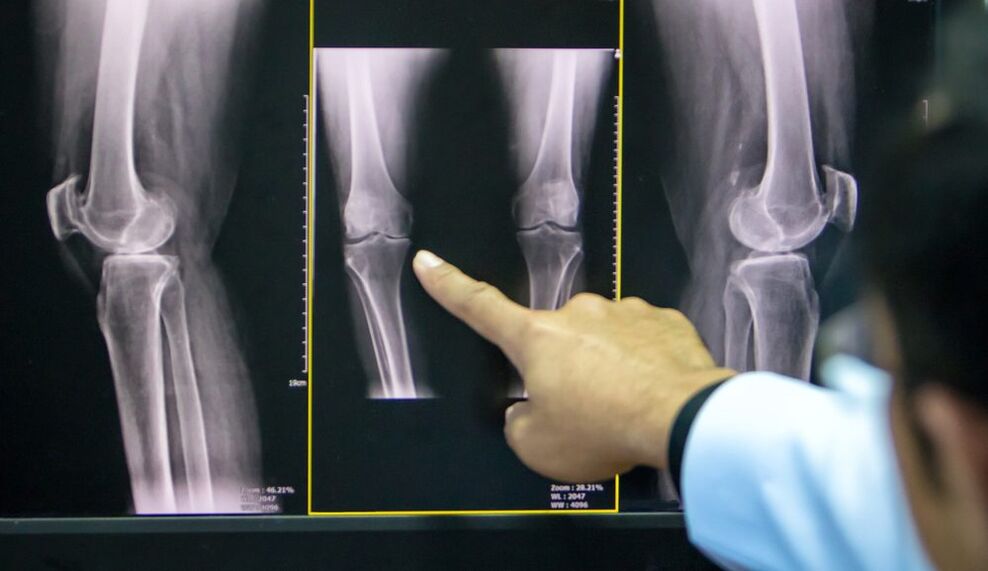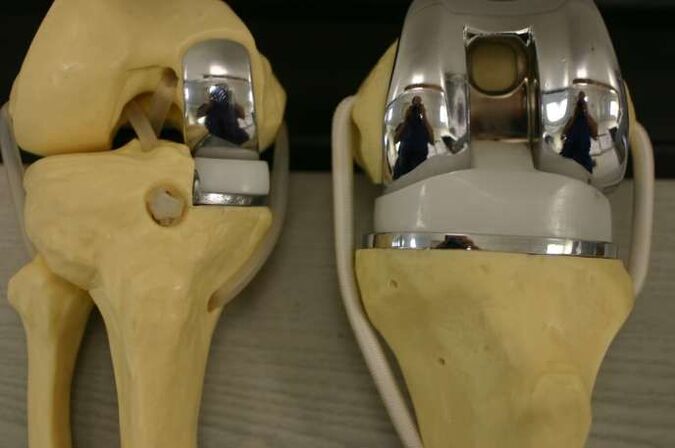Gonarthrosis of the knee joint is the most common localization of degenerative-dystrophic disease characterized by gradual destruction of cartilage with subsequent changes in the joint surfaces, which is accompanied by pain and reduced mobility.

The disease is more common in women over the age of 40, especially those who are overweight and have varicose veins in the lower extremities.
The knee joint consists of three sections:
- medial tibiofemoral;
- lateral tibiofemoral;
- suprapatellar-femoral.
Deforming osteoarthritis (DOA) can affect these parts individually and in any combination. 75% of all cases of gonarthrosis are destruction of the medial tibiofemoral section (during movement, he experiences a load that exceeds body weight by 2-3 times).
In young patients, only one joint is more often destroyed - the right or left (right or left gonarthrosis).
Causes of DOA of the knee joint
Several factors may be involved in the development of degenerative cartilage changes simultaneously:
- mechanical overload of the knee joint (some specialties, sports) with microtraumatization of cartilage;
- consequences of injuries, surgical interventions (meniscectomy);
- inflammatory diseases of the knee (arthritis);
- anatomical inconsistencies of joint surfaces (dysplasia);
- violation of statics (flat feet, curvature of the spine);
- chronic hemarthrosis (accumulation of blood in the synovial cavity);
- metabolic pathologies (gout, hemochromatosis, chondrocalcinosis);
- excess weight;
- violation of the blood supply to the bones;
- osteodystrophy (Paget's disease);
- neurological diseases, loss of sensation in the limbs;
- endocrine disorders (acromegaly, diabetes mellitus, amenorrhea, hyperparathyroidism);
- genetic predisposition (generalized forms of osteoarthritis);
- violation of type II collagen synthesis.
But in 40% of cases, it is impossible to determine the underlying cause of the disease (primary arthrosis).
Pathogenesis of gonarthrosis
initial phase
In the initial phase of the disease, the processes of cartilage metabolism are disturbed. The synthesis and quality of the main structural unit of cartilaginous tissue, proteoglycans, which are responsible for the stability of the structure of the collagen network, are reduced.
As a result, chondroitin sulfate, keratin, hyaluronic acid are washed out of the network, and structurally defective proteoglycans can no longer retain water. It is absorbed into collagen, whose swollen fibers reduce the cartilage's resistance to stress.
Pro-inflammatory substances accumulate in the synovial cavity, under the influence of which cartilage is destroyed even faster. Fibrosis of the joint capsule develops. Changing the composition of synovial fluid makes it difficult to deliver nutrients to the cartilage and makes it difficult for the joint surfaces to slide during movement.
Progression of pathology
In the future, the cartilage gradually becomes thinner, becomes rough, cracks appear in the entire thickness. The epiphyses of the bones experience an increased load, which causes the development of osteosclerosis and compensatory proliferation of bone tissue (osteophytes).
This reaction of the body is aimed at increasing the surface area of the joint surfaces and redistributing the load. But the presence of osteophytes increases discomfort, deformity and further limits limb mobility.
Microfractures occur in the thickness of the bone, damaging the blood vessels and leading to intracutaneous hypertension. In the last phase of osteoarthritis, the joint surfaces are completely exposed, deformed, and the movements of the limbs are sharply limited.
Symptoms of gonarthrosis of the knee joint
Osteoarthritis of the knee joint is characterized by a chronic, slowly progressive course (months, years). The clinic is growing gradually, without pronounced exacerbations. The patient cannot remember exactly when the first symptoms appeared.
Clinical manifestations of gonarthrosis:
- bol. At the beginning, they are diffuse, short (with long standing, walking up the stairs), and as osteoarthritis progresses, the pain becomes local (front and inner surface of the knee), their intensity increases;
- local sensitivity to palpation. Mainly on the inside of the knee along the edge of the joint space;
- crunching. In phase I it can be inaudible, in phase II-III it follows all movements;
- increase in volume, deformation of the knee. As a result of the weakening of the lateral ligaments, the person develops an O-shaped limb configuration (clearly visible even in the photograph);
- restriction of mobility. In the beginning, there are difficulties with bending the knees, later - with extension.
Causes of pain in DOA:
- mechanical friction of damaged joint surfaces;
- increased intraosseous pressure, venous congestion;
- joining synovitis;
- changes in periarticular tissue (stretching of the capsule, ligaments, tendons);
- periosteal thickening;
- phenomena of dystrophy in adjacent muscles;
- fibromyalgia;
- compression of nerve endings.
Unlike coxarthrosis, DOA of the knee can show spontaneous regression of symptoms.
Clinical manifestations of gonarthrosis depending on the stage:
> zxtable border = "1" cellpadding = "0" >A common complication of osteoarthritis of the knee joint is secondary reactive synovitis, which is characterized by the following symptoms:
- growing pain;
- swelling;
- effusion into the synovial cavity;
- increase in skin temperature.
Less common and more dangerous complications are: joint block, osteonecrosis of the femoral condyle, patellar subluxation, spontaneous hemarthrosis.
Diagnosis of DOA of the knee joint
The diagnosis of gonarthrosis is based on the patient's characteristic problems, changes observed during the examination and the results of additional examinations.

To confirm osteoarthritis, the following is prescribed:
- radiography of the knee joint in two projections (anteroposterior and lateral): the most accessible way to confirm the diagnosis in the advanced stage of pathology;
- Ultrasound: determining the presence of effusions in the joint, measuring the thickness of cartilage;
- synovial fluid analysis;
- diagnostic arthroscopy (visual assessment of cartilage) with biopsy;
- computed tomography and magnetic resonance imaging (CT, MRI): the best method for diagnosing DOA in the early stages.
If the doctor doubts the diagnosis, he may prescribe:
- scintigraphy: scanning of the joint after the introduction of a radioactive isotope;
- thermography: study of the intensity of infrared radiation (its strength is directly proportional to the intensity of inflammation).
Treatment of gonarthrosis of the knee joint
The osteoarthritis treatment regimen combines several approaches: drug-free methods, pharmacotherapy, and surgical correction. The ratio of each method is determined individually for each patient.
Drug-free treatment
In the latest ESCEO (European Society for the Clinical Aspects of Osteoporosis and Osteoarthritis) guidelines on how to treat osteoarthritis of the knee, experts place special emphasis on educating patients and changing lifestyles.

The patient needs:
- explain the essence of the disease, set for long-term treatment;
- learn how to use aids (sticks, orthoses);
- prescribe a diet (for patients with a body mass index greater than 30);
- give a set of exercises to strengthen the thigh muscles and relieve the knee joint;
- explain the importance of increased physical activity.
In the early stages of osteoarthritis of the knee, physiotherapy treatments give good results:
- massage;
- magnetotherapy;
- UHF therapy;
- electrophoresis;
- hydrogen sulfide baths;
- paraffin applications;
- acupuncture.
Pharmacotherapy of gonarthrosis
The use of drugs in DOA is aimed at relieving pain, reducing inflammation and slowing the rate of cartilage destruction.
Symptomatic treatment:
- analgesics;
- non-steroidal anti-inflammatory drugs (NSAIDs) of the COX-2 inhibitor group in the form of tablets or suppositories;
- non-narcotic analgesics (with resistant pain syndrome).
Structural drugs (chondroprotectors):
- chondroitin sulfate;
- Glucosamine sulfate.
These drugs can be taken in the form of capsules in courses several times a year, injected intramuscularly or directly into the synovial cavity.
Topical therapy includes intra-articular injections of glucocorticosteroids, hyaluronic acid preparations.
In phases I – II of DOA, the use of anti-inflammatory ointments, gels and creams based on NSAIDs occupies an important place in complex therapy. They help reduce the patient's need to take NSAIDs orally, which reduces the risk of damage to the digestive tract.
Folk remedies
The use of tinctures, decoctions, extracts, topical application of medicinal herbs should be considered auxiliary methods for the treatment of DOA, folk remedies can not replace the therapy prescribed by a doctor.
Herbs used in osteoarthritis: dandelion, ginger, Jerusalem artichoke, burdock, garlic, sea buckthorn.
Operation
Surgical intervention may be required at all stages of gonarthrosis with insufficient effect of medical measures. Endoscopic procedures are the most common, and in the most severe cases, replacement of the endoprosthesis is indicated.

Types of endoscopic interventions:
- revision and rehabilitation of the joint: extraction of inflammatory contents from the synovial cavity, cartilage fragments;
- plasma or laser ablation: removal of mechanical obstructions in the synovial cavity;
- chondroplasty.
Corrective periarticular osteotomy is indicated for patients with initial manifestations of axial limb deformity (not more than 15-20%).
The purpose of the operation is to restore the normal configuration of the joint, evenly distribute the load on the joint surface and remove the damaged areas. This procedure allows you to delay arthroplasty.
Indications for replacing the affected area (or the entire joint) with an artificial one:
- DOA II-III degree;
- severe axial limb deformity;
- aseptic necrosis of the subchondral layer of bone;
- persistent pain syndrome.
Contraindications for knee arthroplasty:
- total joint damage;
- unstable ligament apparatus;
- DOA as a consequence of inflammatory arthritis;
- persistent flexion contracture, severe muscle weakness.
In this case, the patient undergoes arthrodesis - a comparison of the knee joint in a physiological position with the removal of joint surfaces. This relieves pain but shortens the leg, causing secondary lesions in the contralateral knee, hip, and spine.
Prevention
Prevention of premature cartilage degeneration should begin in childhood.
Precautions:
- scoliosis prevention;
- correction of flat feet (shoes with arch supports);
- regular physical education (limit heavy sports);
- switching off fixed positions during operation.

























